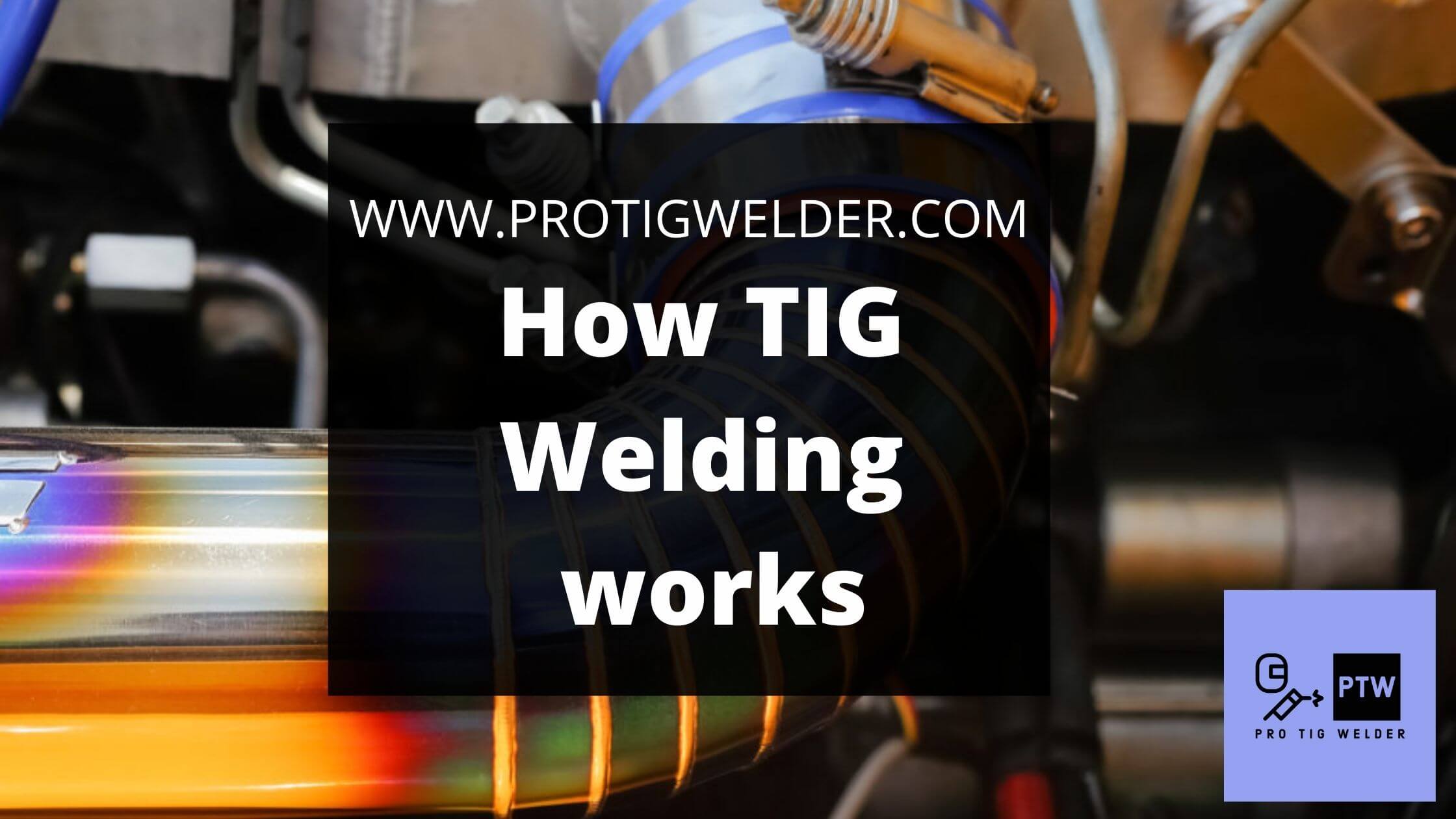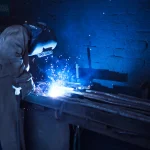TIG welding is a type of welding that is used in the construction and fabricating industries. TIG (tungsten inert gas) welding uses a non-consumable tungsten electrode with an inert shielding gas like argon to produce metal welds on various metals. A common misconception about TIG welding is that it only works on stainless steel, but this is not true. It can be used as welds on almost any metal surface, such as copper or low carbon steel.
How TIG Welding Works?
TIG welding works by creating an electric arc between the tungsten electrode and the metal surface that needs to be welded. This arc is created when alternating current flows through both electrodes, creating a short circuit. The short circuit is created by electrons flowing from the negatively charged cathode (electrode) around to the positively charged electrode. This is possible because of the inert shielding gas, which allows the electricity to pass freely between both electrodes.
The benefits of TIG welding over other types of welding include greater control and precision, as well as a more accurate and cleaner weld bead. It can effectively weld materials like nickel alloys that cannot be successfully welded by some other methods. It is also a great process for welding materials that cannot be melted with other types of welding, such as titanium and aluminum.
TIG welding types
There are three main types of TIG welding: manual, semi-automatic, and automatic.
Manual TIG welding is the most basic type and is done completely by hand. Semi-automatic TIG welding is done with the help of a foot pedal or machine to start and stop the welding process, but the weld bead is still placed manually. Automatic TIG welding is the most advanced type and is completely automated; the welder simply sets the parameters and the machine does the rest.
Manual TIG Welding:
One of the most popular types of TIG welding is manual TIG welding. This type is typically used when the metal being welded is in tight corners or in difficult-to-reach places. These can be difficult to weld without the use of a mechanized device that would help you with your work. To do this type of welding, you will need a TIG torch, which attaches to an air compressor and argon gas cylinder. Next, put on protective equipment including gloves, safety glasses, and coveralls. Turn on the compressed air supply so it mixes with your argon gas supply. Now turn your oxygen regulator knob so it’s at around 30%. After, mix the two together until you see blue color in your torch nozzle. Now, slowly touch the tungsten electrode to the metal you are wanting to weld. This should produce a small shower of brilliant light and give off sufficient heat to start welding.
Semi-automatic TIG Welding
Semi-automatic TIG welding is a process that uses a TIG welder to create a weld. The TIG welder is connected to a power supply and a water cooling system. The welder uses an electrode to create the weld, and the shielding gas is supplied by a gas bottle. This type of welding is used when the welder does not have to work with the metal material in a hands-on manner.
Single Line Voltage Welding (SLV) and Dual Line Voltage Welding (DLV)
The Single Line Voltage Welding process uses both DC positive and DC negative cables that connect to a TIG welder. The TIG welder is connected to a power supply and water cooling system. Single Line Voltage Welding is used for low amperage weldings, like thinner metals like aluminum or thin steel materials that are around 1/8 inch thick or less. Dual Line Voltage Welding uses both DC positive and DC negative cables that connect to the welder and both can be adjusted remotely. This type of welding is used to make stronger welds on thicker materials like metal sheets that are around 3/16 inches thick or more.
Automatic TIG Welding
Automatic TIG welding is a great option for companies who want to minimize their expenses on production time due to its ability to create a clean, neat appearance with regular straight edges. By employing this advanced process, companies are able to produce high-quality products in less time than other welding machines.
The process starts by clamping together your pieces and inserting a rod into a pre-drilled hole through the joint you are connecting. Once it is securely fastened, the welder will direct a constant and stable electrical current through the piece. The anode (non-consumable) electrode is connected to the welder itself and used to create heat that will allow for the fusion of metals that are not traditionally compatible such as steel and aluminum. The flow of inert gas that is fed into the welding rod will shield the metal from contaminants in the air and keep it free of impurities.
Benefits of using TIG-welded standard benefits:
- TIG welding is a more precise method of welding.
- The welds are stronger and more durable than other types of metal welds.
- You’ll be able to get your projects done faster with less hassle.
- Your customers will love the quality you provide.
- It’s fun!
Drawbacks to using a TIG welder
TIG welding has many advantages. The machine is lightweight and does not require a large storage space like other welding machines. It does, however, require the operator to use a high-frequency machine due to the continuous motion of the machine during operation.”TIG Welding allows for very little spatter, which produces a tidy and more attractive finished product”
However, due to the high frequency required, the machine is often unable to perform on metals with low conductivity. For example, some aluminum alloys have insufficient conductivity to produce a proper weld. In this case, a lower current level must be used and the welder should be equipped with a special roller pulse.
How to use a tig welder
To start TIG welding, the machine must be set to produce a TIG weld. You should also adjust the wire feed speed and wire feed force as necessary for your type of metal. When using a TIG welder, you will need to create a helix on the back of the strip electrode to prepare it for welding. This is done by spinning it between your fingers so that the tip of the electrode is at a right angle to your fingers. You can then insert it into the collet and tighten it until it is secure and ready for use. Next, you can use a shielding gas to protect the surface of your metal from any contaminants.
To create the weld, hold the electrode with one hand and touch it to your metal where you want to make a bead. Hold down on the button until a pool of molten metal forms at the end of the welding wire. When this happens, move quickly across your metal so that the pool forms a continuous bead. To finish the weld, you will need to let your electrode cool down until it is red-hot before removing it from the metal. Repeat this process for each bead of molten metal you want to create on your surface.
tip: always use argon or helium to shield your welds.
Best practices for Tig welding jobs
When welding any metal, it is important to do so in a well-ventilated area. The fumes from welding can be harmful to your health, so it’s important to have good ventilation. You should also always wear the proper safety gear, including a welding helmet, gloves, and a welding jacket.
In Tig welding, it’s also important to make sure that the metal you’re welding is clean and free of any contaminants. Before welding, use a wire brush to clean the surface of the metal. You should also remove any paint or rust from the surface.
When welding with Tig, it is important to strike an arc when starting the weld. To do so, hold the tungsten electrode in one hand and the ground clamp in the other. When both are held in place, “slap” the electrode onto the workpiece. Strike an arc for a few seconds, then pull away when you see a small claw of light coming from the electrode.
Once you’ve struck an arc and pulled away, it’s time to begin welding with the Tig welder. Begin moving the TIG welder in a smooth motion while keeping the electrode between five inches and eight inches above the metal. The duty cycle on your Tig welder is what dictates how long you can weld for. If the duty cycle is too short, you won’t be able to complete your Tig welding job within that time period.
When Tig welding copper, there are several things you should keep in mind. Copper requires a special tungsten electrode with a larger diameter to provide enough heat to properly melt the metal.

![What is Spot welding? And How Does It works? [PROTIGWELDER] what is spot welding](https://protigwelder.com/wp-content/uploads/2022/01/what-is-spot-welding-1-150x150.jpg)

![Difference Between TIG and MIG Welding? | [Update 2022] Difference Between TIG and MIG Welding](https://protigwelder.com/wp-content/uploads/2021/12/Difference-Between-TIG-and-MIG-Welding-1-150x150.jpg)


![What is MIG and TIG Welding | Best Guide 2022 [PTW] what is mig and tig welding (1)](https://protigwelder.com/wp-content/uploads/2022/01/what-is-mig-and-tig-welding-1-150x150.jpg)


![What Is Shielded Metal Arc Welding (SMAW) | [Complete Guide] What Is Shielded Metal Arc Welding (SMAW)](https://protigwelder.com/wp-content/uploads/2022/01/What-Is-Shielded-Metal-Arc-Welding-SMAW-150x150.jpg)
![What Is Friction Welding Process? | [Best Guide - PROTIGWELDER] What Is Friction Welding Process](https://protigwelder.com/wp-content/uploads/2022/01/What-Is-Friction-Welding-Process-150x150.jpg)